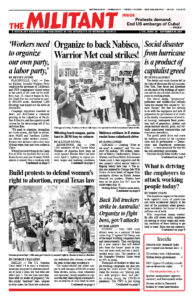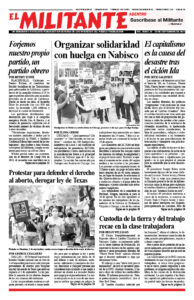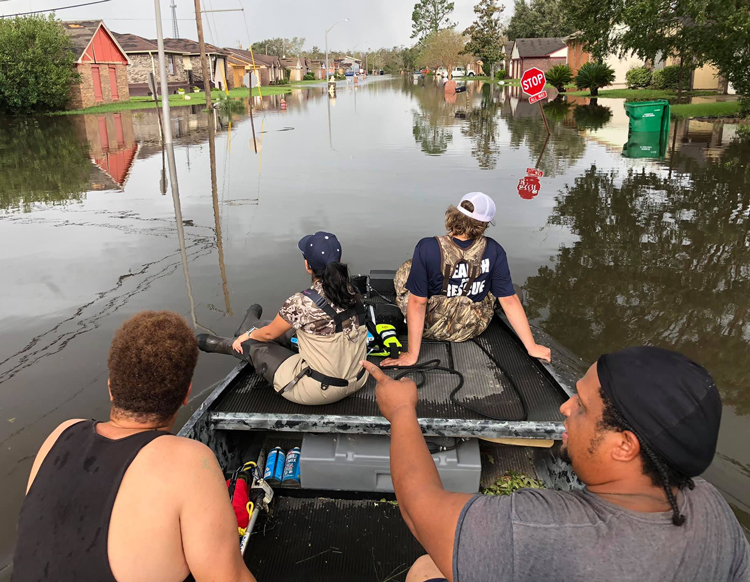The deaths and social disaster left in the wake of Hurricane Ida in Louisiana, New York, New Jersey and elsewhere are the result of the workings of capitalism and the class-divided realities it imposes on working people.
The liberal media, “progressive” politicians and middle-class radicals claim the disaster was caused by “climate change.” But that has nothing to do with the negligence and lack of preparation by government at all levels or the deadly consequences of wretched housing; inadequate flood protection; lack of generators, shelters and storm-resistant electric grids; and virtually nonexistent transportation and evacuation procedures.
The greed, profit drive and scorn for working people by the capitalist class and its government — Democratic and Republican politicians alike — is what prepared the way for the still-unfolding catastrophe.
President Joseph Biden briefly visited some of the damaged areas in Louisiana, New Jersey and New York. He used his trip to tout his so-called infrastructure bill as the way to confront climate change and to promote the illusion that “we’re all in this together.”
At least 71 people died from the storm, the majority in New York and New Jersey, and tens of thousands lost their homes, mostly in Louisiana. More than a half-million homes and businesses there were still without electricity as of Sept. 7 — and many without running water. The vast majority were in working-class areas or farm communities.
Louisiana Gov. John Bel Edwards captured government officials’ disdain for working people when he announced “the first 72 [hours] are on you.” More than a week later it was still “on you,” despite Edward’s boast that he had mobilized 5,100 members of the Louisiana National Guard with 177 high-water vehicles, 74 rescue boats and 34 helicopters.
‘We are on our own’
“We are on our own,” retired worker Irina McAlister told the Militant from New Orleans Sept. 6. She said friends and neighbors have been checking up on and helping each other. Her neighborhood is higher up and mostly suffered wind damage.
There had been no mail service and no garbage collection since the storm, she said. “It’s 90 degrees out and the trash is just sitting there. The rats are having a field day.”
“The National Guard is out guarding property,” she said. “I saw one with a rifle guarding a closed gas station. But no one has come by from the government to see how I’m doing.”
Prioritizing protecting businesses, local governments have imposed curfews and thrown in jail those people out on the streets.
Unlike in the 2005 Hurricane Katrina when the levees burst inundating low-lying working-class neighborhoods of New Orleans, this time they held, after being fortified since. But no such improvements were made in the rest of the state. Farms and homes in small towns and rural areas were flooded out.
While thousands left the area ahead of the storm, with no government-organized evacuation, roads out of the hurricane’s path became gridlocked.
Eight hundred residents from seven nursing homes owned by a Baton Rouge businessman, including some in New Orleans, were evacuated days after the storm to a warehouse in Independence, one of the hardest-hit areas in Louisiana. There was no air conditioning despite the extreme heat and humidity. They were given a mattress to sleep on the floor and a five-gallon bucket to go to the bathroom. Family members weren’t told where they had been taken. Many hadn’t eaten or received medication in 24 hours. By the time the local officials raised alarms seven residents had died.
“I feel like they herded my mom and these poor people like cattle,” Melissa Barbier, whose mother, Madeleine Bergeron, was there.
A week after the storm destroyed their homes, some families were still living inside their vehicles because of bureaucratically slow federal housing aid, booked up hotels, and a lack of money.
Hurricanes are endemic on the Gulf Coast, regardless of climate change. The government’s neglect simply reflects their class outlook.
Cajun Navy volunteers
The United Cajun Navy — working people and small-business owners who first came together to rescue people by boat during Hurricane Katrina, 16 years ago to the day when Ida hit — organized yet again in the face of government inaction. They headed to the hardest-hit areas of Louisiana, including Houma and LaPlace. They sent crews with rafts, tractors and chainsaws to clear roads and to aid as many people as possible. In the absence of adequate shelters, the Cajun Navy has not been evacuating people. “We tell them to keep hunkering down,” the organization’s president, Todd Terrell, told the media. “We don’t have any place to put them.”
The group has distributed truckloads of food, water, other necessities and even hay for ranchers to feed their cattle. Their actions show the power and potential of working-class solidarity.
Working people have organized to help each other out. In Metaire, a western suburb of New Orleans, workers and small businesses pooled their resources and set up barbecue grills, cooking meals for hundreds of their neighbors.
Entergy Louisiana, the electric company, said some areas won’t get power back until the end of September. Little has been done for decades to strengthen the electric system in the hurricane-prone state.
“I hear those officials on my radio saying that it’s a complicated process,” said McAlister. “They think we’re too stupid to understand.”
She noted that power was restored rapidly in the French Quarter, the heart of New Orleans’ tourist industry, because the power lines there are underground. “They say it costs too much to do it everywhere. Well, what is it costing working people right now?”
Entergy pledged after Katrina and hurricanes in 2008 that it would take measures such as using concrete and steel poles for electric lines, instead of wooden ones. Even without going underground, lines can be reinforced to withstand 140-mile-an-hour winds.
But that would lessen profits. In 2018 an Entergy executive admitted that the company cut funds for strengthening the power grid. They “didn’t want to spend money,” she claimed, when the system “was performing extremely well.”
By the time Ida reached the Northeast, it was no longer even a tropical storm. But the three inches of rain it dropped at times in an hour left more dead there than in Louisiana, many of them drowned in their basement apartments in New York City or vehicles caught in floodwaters in New Jersey. Others barely escaped rapidly flooding New York subway stations.
A few days after the flooding, the Gothamist spoke to more than a dozen residents of one block in the borough of Queens where almost every home was damaged. “No one has come by. My house is destroyed,” Antonio Mayo said.
New York City Mayor Bill de Blasio washed his hands of all responsibility when touring a heavily damaged Queens neighborhood with Democratic Socialist Congresswoman Alexandria Ocasio-Cortez a week after the storm. He said blame for the disaster should be placed on inaccurate weather forecasters.
Some area residents let de Blasio have it. Isabella Lizad, a physical therapist whose basement was flooded, told the Daily News, “They swore they would fix the sewers” after flooding in 2008. “And here we are again. Nine people died in this neighborhood.”
In fact, city officials are well aware that tens of thousands of people are living in wretched basements and have done nothing to build decent, affordable housing. And they have been discussing for well over a decade the need to fix the city’s sewer system, parts of which are more than 150 years old.


